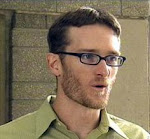 From: Free Leonard Peltier (8728841)
From: Free Leonard Peltier (8728841)
To: (390120061)
Date: 6/29/2009 5:11:14 PM
Subject: Statement from Leonard Peltier ~ Reading by: Wanbli
photo 1: "Free Leonard", by Lana Banana
Statement from Leonard Peltier (6.26.09)
Greetings my friends and relatives,
I want to start off this statement or speech or whatever you want to call it by saying again as I’ve said before thank you thank you thank you from the bottom of my heart for supporting me and for standing up for right wherever you are. I can’t express to you in words how extremely grateful I am not just to the people of America but to the people all over the world who have supported the cause of Indian people and myself.
I know a lot of you have given up a lot to help so many in my predicament. Daily I am made aware of political prisoners around the world. Many who have been killed or tortured or who knows what for trying to right the wrongs in their area, country or nation. I have been asked to make statements in support of other movement people around the world from time to time, South America, Europe and other places. People who love freedom, people who love the earth, people
who love their family, people who love the freedom to make their own choice with their own resources, and all indigenous people- we share a common bond. The bond of brother and sister hood, the bond of believing there is a greater power than ourselves. And I don’t mean some government power; I mean the greatest power in all the universe
the Creator Himself.
We also as human beings upon this earth have to recognize that there have always been those who suffer from an illness called greed. They have an appetite for gaining material wealth that is never satisfied. They have an appetite for land that is never satisfied. And the most common symptom of their illness is indifference to the suffering they cause with their quest. These people are the ones that have identified themselves as our common enemy. It is so terrible that
under the guise of religion and shouting freedom they pit one people against another. This isn’t something new. All down through history it has taken place. All down through history there have been men, spiritual men, holy men, great thinkers and philosophers who have tried to unite us against this common enemy.
Today my brothers and sisters I want you to know that if nothing else if we don’t unite against the destruction against the Mother Earth we will have a common future that is void of clean air, clean water, and basic freedoms. We must reach our hands out to embrace others to the cause of life. We must do our best from where ever we are with whatever tools available to enhance and further our quality of life. We must find a way to break down the barriers that divide one people
from another. We must find the things we have in common and find ways to solve our differences as basic humanity. We must evolve to a higher level of thinking or to as you might say a traditional level of thinking which obviously is superior to what they call progress today. Our traditional values taught us to live in harmony with Earth the greatest manifestation of the Creator that we have to relate to. Our traditions taught us to respect our bodies the greatest gift we have or possess as an individual. Our traditions taught us to preserve the environment for our children and all our future generations. As a
member of the American Indian Movement these values are what we were about. Poverty isn’t solved by money poverty is solved by attitude. The problems we have today among all our people are caused by attitude. They are caused by an attitude that was given to us in boarding schools and on reservations that were nothing more than concentration camps in the past. They are attitudes by people who came to us talking to us about God and wanting us to embrace their version of religion and as one brother said once, “They told us to bow our heads, and when we looked up our land was gone, our culture was gone, our children was gone, our way of life was gone.” And now the air itself is dwindling.
I have been in this cage for some 34 years and though I have been caged I have sought the spirit in prayer of our brother the eagle, I have sought to have an overview of things for as anyone can see I don’t have the freedom to examine life from a close perspective. And from this distant view, abstract view, this detached view, at times I get to see the destruction and divisiveness that these political powers that have scattered us for so long have involved themselves in
promoting among our people. I don’t know if it is because I am older now or because my future is so uncertain or if through some spiritual inspiration I deeply want to say so much. I deeply want to move you to do something to save our earth and our children and our children’s future. I didn’t get to raise my children; I haven’t got to really know them or my children’s children. I may never get to, but I love them all just the same. And I love life as much as anyone on the outside. And I don’t know how long I will walk this cage. Some days I feel quite healthy and energized and some days I feel like the 64 year old man that I am. I’m always hopeful that I will be free at some point, perhaps in the latter part of July after my parole hearing, and perhaps I won’t. The people that hold me, the FBI and the conglomerate corporations that have for so long controlled the resources of this country and others and for so long have done their best to stifle, to denigrate, and to vilify the voice of the oppressed are some of the most formidable well funded political people on Earth. I was told that the FBI themselves are some 10,000 strong.
I am but a common man, I am not a speaker but I have spoken. I am not all that tall but I have stood up. I am not a philosopher or poet or a singer or any of those things that particularly inspire people but the one thing that I am is the evidence that this country lied when they said there was justice for all. I am the evidence that they lied when they extradited me from Canada. I am the evidence that they can lie at your trial, they can manufacture evidence at your trial, they can intimidate witnesses at your trial, they can have back room conversations and agreements with the judge at your trial. I am the evidence that the attitude, the powers that be still hold us in a grip. They hold us in an emotional grip. They hold us in a poverty grip. They hold us in a cultural deprivation grip. I could go on and on about the things that go on that weigh so heavily against our people but the bottom line is my case is well documented by court after court after court, by hearing after hearing after hearing, by statement after statement after statement. And we as a people are the evidence that this country fails to keep its treaties, this country fails to keep its word. This country has failed to follow its own Constitution - the treaty between the people and the government. We are that evidence. I am nothing more than evidence. That is why people all over the world and here at home have supported the cause of justice in my case. In my particular situation I can’t say that there will ever be any level of justice.
They cannot give back the 34 years of life that have been taken from me. They can not give back the life of Joe Stuntz that they took June 26th 1975. They cannot give back the lives of the 60 something people that they directly or indirectly caused the death of. They cannot give back the thousand upon thousands of Indian people that were killed and abused since the inception of this government. But the one thing we can do, we must do, is find a way to change their attitude. My brother Leonard Crow Dog once said, “If you want to change the white man you have to change his religion.” And religion is a word that means how you do something on a regular basis; most generally it is associated with your spirituality. Perhaps with global warming as it is and the changes in the weather patterns and the questionable future that faces the earth, they will start to listen. Maybe they will reach back and embrace the words of our people foretold again and again. We must live the way that the Earth will renew itself every spring. We must help them reach back. We must speak to them at every opportunity. We must make an effort to reach back ourselves to our own cultural values. And in doing so we can start to solve the many destructive challenges we face. We must more than ever before find a way to heal the wounds of our children and prevent the social illnesses that are so prevalent across our reservations and communities. We have the tools, we have the teachings, we have the philosophies, we have the culture, we have the artists, we have the singers, we have the philosophers, I could go on and on but in essence what I am trying to say is it is imperative that we bring together all our resources to enhance the future for our children in a way that they themselves can further the healthy teachings of our culture and way of life; and in doing so I have no doubt that we can change the world.
If I am freed next month or if I die in prison remember my words and remember we are evidence that the Creator made a beautiful people a people that respected the Earth and nature and each other. We are evidence on every level of goodness that when the Creator made us He meant for us to be free. All our traditions have taught us this way. And even this very form of government that exists today was copied from our people. Our people with our foods, our medicines, belief in freedom and right to choose have influenced the world. Its too bad they didn’t adopt a healthy attitude that we had toward the Earth or an attitude of respect for us the first keepers of this portion of the Earth. If there is something about me that this government can point at and say is wrong or any person say is wrong I will by my own choice, if it proves to be fact, seek to fix it myself. But I also want to remind them the policies that have been in place for so long have made us what we are today. The policies that have been in place for so long, have created another reservation called Iraq and another reservation called Afghanistan, and the list goes on and on, you see what’s happening over there is what happened here and all down through North and South America.
I am just a common man and I am evidence that the powers that put me here would like to sweep under the carpet. The same way they did all of our past leaders, warriors and people they massacred. Just as at Wounded Knee the Fifth Cavalry sought its revenge for Custer’s loss and massacred some 300 Indian men women and children then gave out 23
Medals of Honor and swept the evidence of their wrongdoing aside. Perhaps this statement is somewhat more lengthy than the others I’ve made; perhaps it is some things I should have said before and perhaps more, if so I hope you will forgive me. I recently was thought to be having a heart attack because of pain in my chest. After having been beaten and kicked and stomped in the last year, I am not quite sure what was causing the pain. I had never been beaten, kicked and
stomped like that before. And also I have never been 64 years old before. The one thing all this did for me is it really brought home my sense of mortality. I don’t want to spend the rest of my life in this prison. And I don’t want you to spend the rest of your life in some prison of the mind, heart or attitude. I want you to enjoy your life.
If nothing else give somebody a hug for me and say, “This is from Leonard.”
In the Spirit of Crazy Horse,
Leonard Peltier

PLEASE CONSIDER WRITING THE PAROLE BOARD ON BEHALF OF LEONARD. TIME'S RUNNING OUT. Below, find a suggested letter from Leonard himself.
{DATE HERE}
Ste 420
Re: Leonard Peltier
Dear Parole Commission:
Considering this evidence and mount of time now passed, it has become crystal clear that Leonard Peltier was persecuted based upon his beliefs and refusal to accept the injustices imposed upon the peoples at Pine Ridge, during that time.
Because of these facts, our system proved itself a failure, and the continued incarceration of Mr. Peltier is a sad commentary of not only the U.S. government, but the humanitarian values our nation professes to have for one - another.
It is my express and deep hope that your commission grant parole and release to Mr. Leonard Peltier. Thank you for your time.
Sincerely,
{YOUR NAME HERE}
***********************************************************************************************
Live your values. Love your country.
And, remember: TOGETHER, We can make a DIFFERENCE!





























